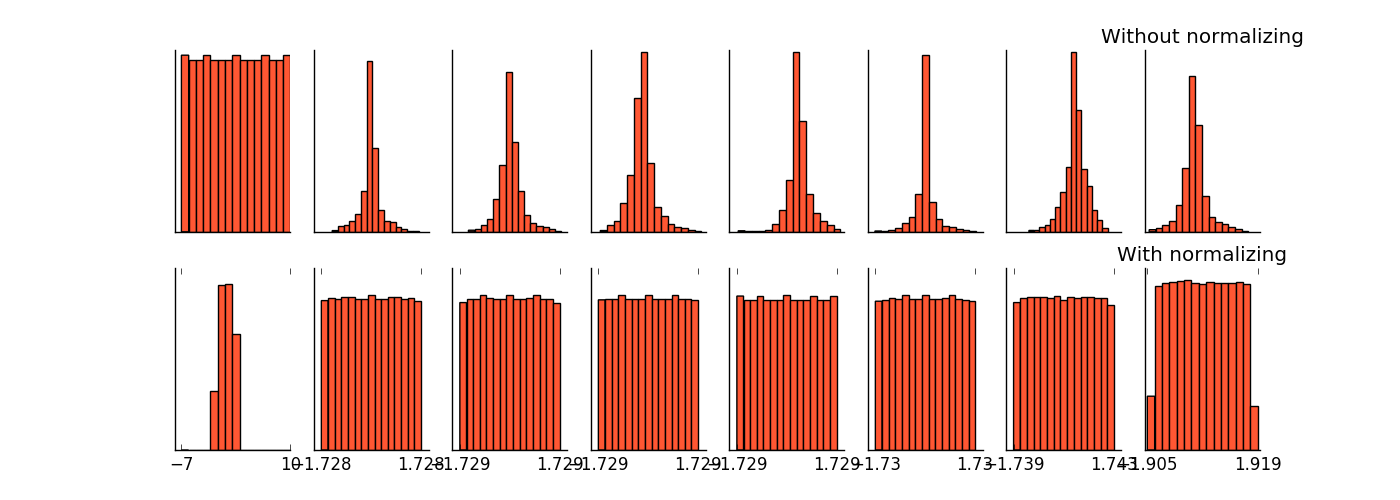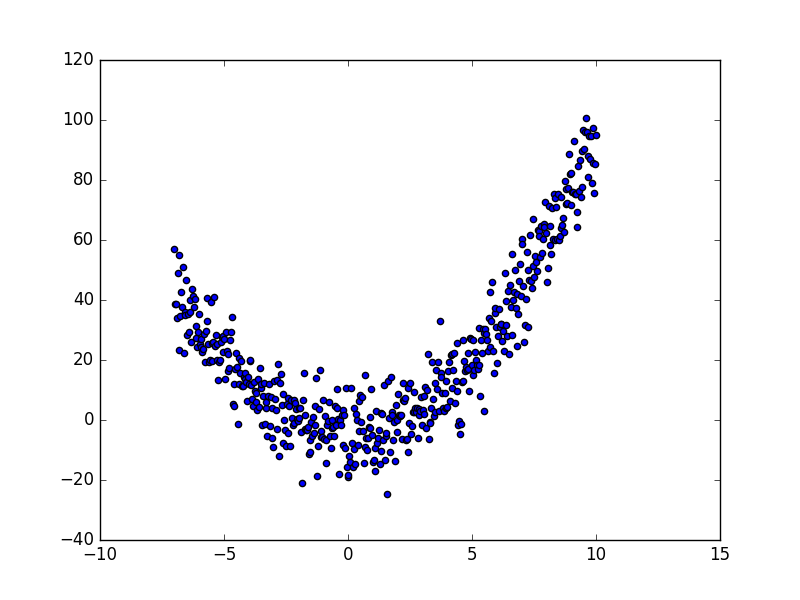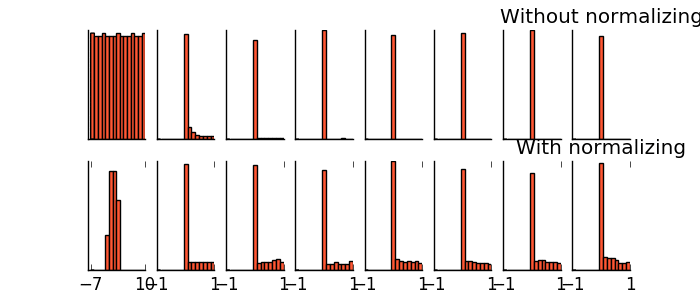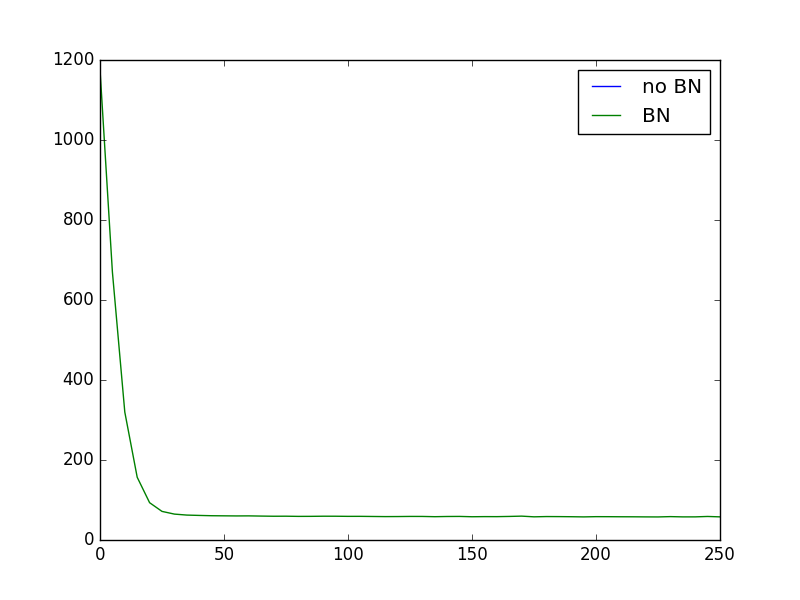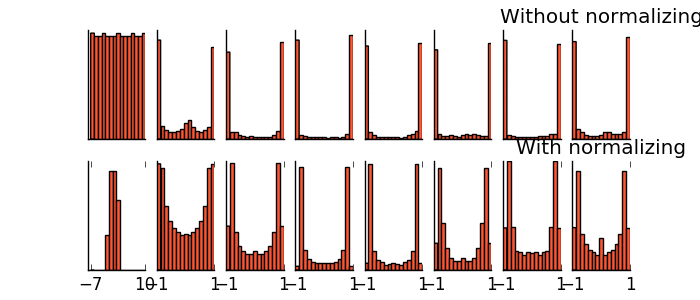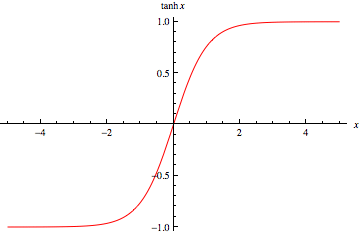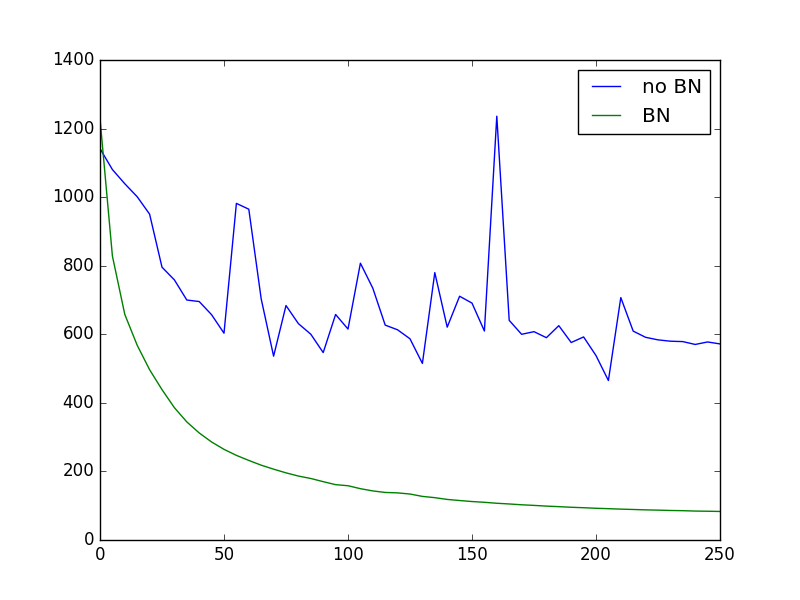Batch Normalization 批标准化
学习资料:
- Batch normalization paper
- 本节相关代码
- 为 TF 2017 打造的新版可视化教学代码
- 我制作的 Batch normalization 简介视频
什么是 Batch Normalization ¶
请参考我制作的 Batch normalization 简介视频 Batch normalization 是一种解决深度神经网络层数太多, 而没办法有效前向传递(forward propagate)的问题. 因为每一层的输出值都会有不同的 均值(mean) 和 方差(deviation), 所以输出数据的分布也不一样, 如下图, 从左到右是每一层的输入数据分布, 上排的没有 Batch normalization, 下排的有 Batch normalization.
我们以前说过, 为了更有效的学习数据, 我们会对数据预处理, 进行 normalization (请参考我制作的 为什么要特征标准化). 而现在请想象, 我们可以把 “每层输出的值” 都看成 “后面一层所接收的数据”. 对每层都进行一次 normalization 会不会更好呢? 这就是 Batch normalization 方法的由来.
搭建网络 ¶
输入需要的模块和定义网络的结构
import numpy as np
import tensorflow as tf
import matplotlib.pyplot as plt
ACTIVATION = tf.nn.relu # 每一层都使用 relu
N_LAYERS = 7 # 一共7层隐藏层
N_HIDDEN_UNITS = 30 # 每个层隐藏层有 30 个神经元
使用 build_net() 功能搭建神经网络:
def built_net(xs, ys, norm):
def add_layer(inputs, in_size, out_size, activation_function=None):
# 添加层功能
Weights = tf.Variable(tf.random_normal([in_size, out_size], mean=0., stddev=1.))
biases = tf.Variable(tf.zeros([1, out_size]) + 0.1)
Wx_plus_b = tf.matmul(inputs, Weights) + biases
if activation_function is None:
outputs = Wx_plus_b
else:
outputs = activation_function(Wx_plus_b)
return outputs
fix_seed(1)
layers_inputs = [xs] # 记录每层的 input
# loop 建立所有层
for l_n in range(N_LAYERS):
layer_input = layers_inputs[l_n]
in_size = layers_inputs[l_n].get_shape()[1].value
output = add_layer(
layer_input, # input
in_size, # input size
N_HIDDEN_UNITS, # output size
ACTIVATION, # activation function
)
layers_inputs.append(output) # 把 output 加入记录
# 建立 output layer
prediction = add_layer(layers_inputs[-1], 30, 1, activation_function=None)
cost = tf.reduce_mean(tf.reduce_sum(tf.square(ys - prediction), reduction_indices=[1]))
train_op = tf.train.GradientDescentOptimizer(0.001).minimize(cost)
return [train_op, cost, layers_inputs]
创建数据 ¶
创造数据并可视化数据:
x_data = np.linspace(-7, 10, 500)[:, np.newaxis]
noise = np.random.normal(0, 8, x_data.shape)
y_data = np.square(x_data) - 5 + noise
# 可视化 input data
plt.scatter(x_data, y_data)
plt.show()
Batch Normalization 代码 ¶
为了实现 Batch Normalization, 我们要对每一层的代码进行修改, 给 built_net 和 add_layer 都加上
norm 参数, 表示是否是 Batch Normalization 层:
def built_net(xs, ys, norm):
def add_layer(inputs, in_size, out_size, activation_function=None, norm=False):
然后每层的 Wx_plus_b 需要进行一次 batch normalize 的步骤, 这样输出到 activation 的 Wx_plus_b 就已经被 normalize 过了:
if norm: # 判断书否是 BN 层
fc_mean, fc_var = tf.nn.moments(
Wx_plus_b,
axes=[0], # 想要 normalize 的维度, [0] 代表 batch 维度
# 如果是图像数据, 可以传入 [0, 1, 2], 相当于求[batch, height, width] 的均值/方差, 注意不要加入 channel 维度
)
scale = tf.Variable(tf.ones([out_size]))
shift = tf.Variable(tf.zeros([out_size]))
epsilon = 0.001
Wx_plus_b = tf.nn.batch_normalization(Wx_plus_b, fc_mean, fc_var, shift, scale, epsilon)
# 上面那一步, 在做如下事情:
# Wx_plus_b = (Wx_plus_b - fc_mean) / tf.sqrt(fc_var + 0.001)
# Wx_plus_b = Wx_plus_b * scale + shift
# 如果你已经看不懂了, 请去我最上面学习资料里的链接 (我制作的 Batch normalization 简介视频)
如果你是使用 batch 进行每次的更新, 那每个 batch 的 mean/var 都会不同, 所以我们可以使用 moving average 的方法记录并慢慢改进 mean/var 的值.
然后将修改提升后的 mean/var 放入 tf.nn.batch_normalization().
而且在 test 阶段, 我们就可以直接调用最后一次修改的 mean/var 值进行测试, 而不是采用 test 时的 fc_mean/fc_var.
# 对这句进行扩充, 修改前:
Wx_plus_b = tf.nn.batch_normalization(Wx_plus_b, fc_mean, fc_var, shift, scale, epsilon)
# 修改后:
ema = tf.train.ExponentialMovingAverage(decay=0.5) # exponential moving average 的 decay 度
def mean_var_with_update():
ema_apply_op = ema.apply([fc_mean, fc_var])
with tf.control_dependencies([ema_apply_op]):
return tf.identity(fc_mean), tf.identity(fc_var)
mean, var = mean_var_with_update() # 根据新的 batch 数据, 记录并稍微修改之前的 mean/var
# 将修改后的 mean / var 放入下面的公式
Wx_plus_b = tf.nn.batch_normalization(Wx_plus_b, mean, var, shift, scale, epsilon)
那如何确定我们是在 train 阶段还是在 test 阶段呢, 我们可以修改上面的算法, 想办法传入 on_train 参数,
你也可以把 on_train 定义成全局变量. (注意: github 的代码中没有这一段, 想做 test 的同学们需要自己修改)
# 修改前:
mean, var = mean_var_with_update()
# 修改后:
mean, var = tf.cond(on_train, # on_train 的值是 True/False
mean_var_with_update, # 如果是 True, 更新 mean/var
lambda: ( # 如果是 False, 返回之前 fc_mean/fc_var 的Moving Average
ema.average(fc_mean),
ema.average(fc_var)
)
)
同样, 我们也可以在输入数据 xs 时, 给它做一个 normalization, 同样, 如果是最 batch data 来训练的话, 要重复上述的记录修改 mean/var 的步骤:
if norm:
# BN for the first input
fc_mean, fc_var = tf.nn.moments(
xs,
axes=[0],
)
scale = tf.Variable(tf.ones([1]))
shift = tf.Variable(tf.zeros([1]))
epsilon = 0.001
xs = tf.nn.batch_normalization(xs, fc_mean, fc_var, shift, scale, epsilon)
然后我们把在建立网络的循环中的这一步加入 norm 这个参数:
output = add_layer(
layer_input, # input
in_size, # input size
N_HIDDEN_UNITS, # output size
ACTIVATION, # activation function
norm, # normalize before activation
)
对比有无 BN ¶
搭建两个神经网络, 一个没有 BN, 一个有 BN:
xs = tf.placeholder(tf.float32, [None, 1]) # [num_samples, num_features]
ys = tf.placeholder(tf.float32, [None, 1])
train_op, cost, layers_inputs = built_net(xs, ys, norm=False) # without BN
train_op_norm, cost_norm, layers_inputs_norm = built_net(xs, ys, norm=True) # with BN
训练神经网络:
代码中的 plot_his() 不会在这里讲解, 请自己在全套代码中查看.
sess = tf.Session()
sess.run(tf.global_variables_initializer())
# 记录两种网络的 cost 变化
cost_his = []
cost_his_norm = []
record_step = 5
plt.ion()
plt.figure(figsize=(7, 3))
for i in range(251):
if i % 50 == 0:
# 每层在 activation 之前计算结果值的分布
all_inputs, all_inputs_norm = sess.run([layers_inputs, layers_inputs_norm], feed_dict={xs: x_data, ys: y_data})
plot_his(all_inputs, all_inputs_norm)
sess.run(train_op, feed_dict={xs: x_data, ys: y_data})
sess.run(train_op_norm, feed_dict={xs: x_data, ys: y_data})
if i % record_step == 0:
# 记录 cost
cost_his.append(sess.run(cost, feed_dict={xs: x_data, ys: y_data}))
cost_his_norm.append(sess.run(cost_norm, feed_dict={xs: x_data, ys: y_data}))
plt.ioff()
plt.figure()
plt.plot(np.arange(len(cost_his))*record_step, np.array(cost_his), label='no BN') # no norm
plt.plot(np.arange(len(cost_his))*record_step, np.array(cost_his_norm), label='BN') # norm
plt.legend()
plt.show()
可以看出, 没有用 BN 的时候, 每层的值迅速全部都变为 0, 也可以说, 所有的神经元都已经死了.
而有 BN, relu 过后, 每层的值都能有一个比较好的分布效果, 大部分神经元都还活着.
(看不懂了? 没问题, 再去看一遍我制作的 Batch normalization 简介视频).
Relu 激励函数的图在这里:
我们也看看使用 relu cost 的对比:
因为没有使用 NB 的网络, 大部分神经元都死了, 所以连误差曲线都没了.
如果使用不同的 ACTIVATION 会怎么样呢? 不如把 relu 换成 tanh:
ACTIVATION = tf.nn.tanh
可以看出, 没有 NB, 每层的值迅速全部都饱和, 都跑去了 -1/1 这个饱和区间, 有 NB, 即使前一层因变得相对饱和, 但是后面几层的值都被 normalize 到有效的不饱和区间内计算. 确保了一个活的神经网络.
tanh 激励函数的图在这里:
最后我们看一下使用 tanh 的误差对比:
分享到:
![]()
![]()
![]()
![]()
如果你觉得这篇文章或视频对你的学习很有帮助, 请你也分享它, 让它能再次帮助到更多的需要学习的人.
莫烦没有正式的经济来源, 如果你也想支持 莫烦Python 并看到更好的教学内容, 赞助他一点点, 作为鼓励他继续开源的动力.
